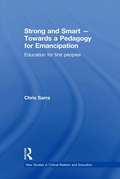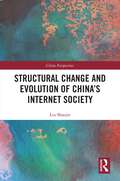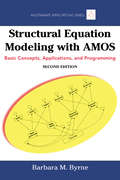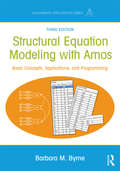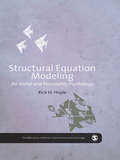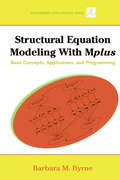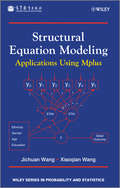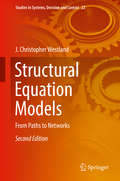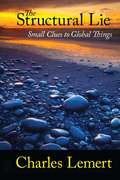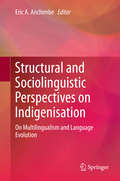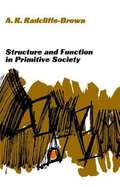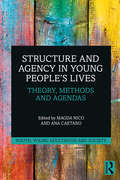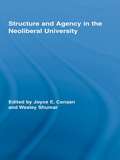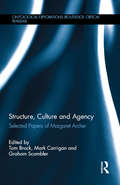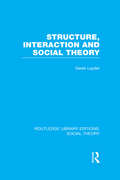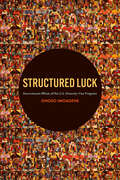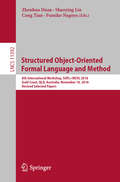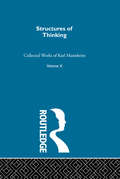- Table View
- List View
Strong Managers, Strong Owners
by Harry Korine Pierre-Yves GomezThe family firm preparing generational change, the partnership that welcomes new partners, and the shareholders of a firm that chooses to go public are making decisions that will have an impact on strategy and management. Conversely, a change in strategy such as a move to diversify or a decision to take on more risk in a business can make the firm more attractive to some shareholders and less attractive to others and is therefore not ownership neutral. Opening the black box of agency theory, Korine and Gomez show how management and ownership interact to shape the strategy of the firm. In their view, the critical question to ask is not what is the best strategy, but rather, who is the strategy for? With numerous detailed examples, Strong Managers, Strong Owners is an invaluable resource for company owners, board members and executives, as well as their advisors in strategy and governance.
Strong Religion, Zealous Media: Christian Fundamentalism and Communication in India
by Pradip ThomasStrong Religion, Zealous Media: Christian Fundamentalism and Communication in India is the first in-depth cultural and social analysis of the growth of conservative forms of Christianity within the Protestant tradition in India and the many ways in which these new churches use the media. Arguing that Christian broadcasting needs to be seen as an essential aspect of a `muscular` Christianity that has increasingly colonised globalising cities such as Chennai, the book concludes with a strong validation of multi-religious India and the need for a robust inter-faith media response to combat religious fundamentalism. This is a highly recommended reading for students, researchers and social scientists involved in religion and media issues, religion departments, seminaries, civil society involved in inter-faith issues and all those who are interested in exploring the politics of religion in the subcontinent.
Strong Women: Inspirational athletes at the top of their game
by Suzanne WrackOverpower. Overtake. Overcome. – Serena WilliamsThroughout history, every woman pulling on spikes, lacing up boots and picking up a racquet has been a rebel – and this explosive book aims to uncover the often hidden histories behind 50 of these incredible pioneers.From the first Black woman to be a professional softball player, Betty Chapman, to the iconic 'Battle of the Sexes' match won by Billie Jean King, and from trans trailblazer Laurel Hubbard to Emma Raducanu's unforgettable US Open win, award-winning sports journalist Suzanne Wrack celebrates sporting giants at the absolute top of their games.
Strong Women: Inspirational athletes at the top of their game
by Suzanne WrackOverpower. Overtake. Overcome. – Serena WilliamsThroughout history, every woman pulling on spikes, lacing up boots and picking up a racquet has been a rebel – and this explosive book aims to uncover the often hidden histories behind 50 of these incredible pioneers.From the first Black woman to be a professional softball player, Betty Chapman, to the iconic 'Battle of the Sexes' match won by Billie Jean King, and from trans trailblazer Laurel Hubbard to Emma Raducanu's unforgettable US Open win, award-winning sports journalist Suzanne Wrack celebrates sporting giants at the absolute top of their games.
Strong and Smart - Towards a Pedagogy for Emancipation: Education for First Peoples (New Studies in Critical Realism and Education (Routledge Critical Realism))
by Chris SarraStrong and Smart – Towards a Pedagogy for Emancipation tells the story of how Dr Chris Sarra overcame low expectations for his future to become an educator who has sought to change the tide of low expectations for other Indigenous students. The book draws upon Roy Bhaskar’s theory of Critical Realism to demonstrate how Indigenous people have agency and can take control of their own emancipation. Sarra shows that it is important for Indigenous students to have confidence in their own strength and ability to be as "able" as any other group within society. The book also compares and contrasts White perceptions of what it is to be Indigenous and Indigenous views of what it is to be an Aboriginal Australian. The book calls for Indigenous Australians to radically transform and not simply reproduce the identity that Mainstream White Australia has sought to foster for them. Here the book explores in what ways Aboriginal and Torres Strait Islander people are "othered" by White Australians. Sarra seeks to advance the novel position that it is OK to be other to White Australia. The question becomes, "which other?" The Indigenous Student should not be treated as the Feared and/or Despised Other, nor should they be coerced into wholly assimilating into White culture.
Structural Change and Evolution of China’s Internet Society (China Perspectives)
by Liu ShaojieThis title investigates China’s network society, both its online cyber society and offline real world society, by analyzing the trends and social foundations of society as network and the social challenges it poses, as well as structural changes in social space and social interaction.The first part of the book examines how network society in China forms and develops, analyzing the challenges and structural changes it poses. The author studies network power and uncertainties that lies in the supply, flow, and reception of a massive amount of information, revealing how this influences the government's administrative power as well as governance measures to stabilize social cohesion. The second part first discusses the social restructuring and characteristics of network social space in China. Based on case studies of several momentous social events, the spatial change characterized by an integration of absence and presence space and its influence on social interaction and experience is elucidated, including active absence interaction, mediated experience, spatial representation, and social identities of network aggregation.The book will be a crucial reference for scholars and students studying sociology, network sociology, and contemporary Chinese society.
Structural Equation Modeling With AMOS: Basic Concepts, Applications, and Programming, Second Edition
by Barbara M. ByrneThis bestselling text provides a practical guide to the basic concepts of structural equation modeling (SEM) and the AMOS program (Versions 17 & 18). The author reviews SEM applications based on actual data taken from her research. Noted for its non-mathematical language, this book is written for the novice SEM user. With each chapter, the author "walks" the reader through all steps involved in testing the SEM model including: an explanation of the issues addressed an illustration of the hypothesized and posthoc models tested AMOS input and output with accompanying interpretation and explanation The function of the AMOS toolbar icons and their related pull-down menus The data and published reference upon which the model was based. With over 50% new material, highlights of the new edition include: All new screen shots featuring Version 17 of the AMOS program All data files now available at www.routledge.com/9780805863734 Application of a multitrait-mulitimethod model, latent growth curve model, and second-order model based on categorical data All applications based on the most commonly used graphical interface The automated multi-group approach to testing for equivalence The book opens with an introduction to the fundamental concepts of SEM and the basics of the AMOS program. The next 3 sections present applications that focus on single-group, multiple-group, and multitrait-mutimethod and latent growth curve models. The book concludes with a discussion about non-normal and missing (incomplete) data and two applications capable of addressing these issues. Intended for researchers, practitioners, and students who use SEM and AMOS in their work, this book is an ideal resource for graduate level courses on SEM taught in departments of psychology, education, business, and other social and health sciences and/or as a supplement in courses on applied statistics, multivariate statistics, statistics II, intermediate or advanced statistics, and/or research design. Appropriate for those with limited or no previous exposure to SEM, a prerequisite of basic statistics through regression analysis is recommended.
Structural Equation Modeling With AMOS: Basic Concepts, Applications, and Programming, Third Edition (Multivariate Applications Series)
by Barbara M. ByrneThis bestselling text provides a practical guide to structural equation modeling (SEM) using the Amos Graphical approach. Using clear, everyday language, the text is ideal for those with little to no exposure to either SEM or Amos. The author reviews SEM applications based on actual data taken from her own research. Each chapter "walks" readers through the steps involved (specification, estimation, evaluation, and post hoc modification) in testing a variety of SEM models. Accompanying each application is: an explanation of the issues addressed and a schematic presentation of hypothesized model structure; Amos? input and output with interpretations; use of the Amos toolbar icons and pull-down menus; and data upon which the model application was based, together with updated references pertinent to the SEM model? tested. Thoroughly updated throughout, the new edition features: All new screen shots featuring Amos Version 23.?? Descriptions and illustrations of Amos’ new Tables View format which enables the specification of a structural model in spreadsheet form.???? Key concepts and/or techniques that introduce each chapter. Alternative approaches to model analyses when enabled by Amos thereby allowing users to determine the method best suited to their data.? Provides analysis of the same model based on continuous and categorical data (Ch. 5) thereby enabling readers to observe two ways of specifying and testing the same model as well as compare results. All applications based on the Amos graphical mode interface accompanied by more "how to" coverage of graphical techniques unique to Amos. More explanation of key procedures and analyses that address questions posed by readers All application data files are available at www.routledge.com/9781138797031. The two introductory chapters in Section 1 review the fundamental concepts of SEM methodology and a general overview of the Amos program. Section 2 provides single-group analyses applications including two first-order confirmatory factor analytic (CFA) models, one second-order CFA model, and one full latent variable model. Section 3 presents multiple-group analyses applications with two rooted in the analysis of covariance structures and one in the analysis of mean and covariance structures. Two models that are increasingly popular with SEM practitioners, construct validity and testing change over time using the latent growth curve, are presented in Section 4. The book concludes with a review of the use of bootstrapping to address non-normal data and a review of missing (or incomplete) data in Section 5. An ideal supplement for graduate level courses in psychology, education, business, and social and health sciences that cover the fundamentals of SEM with a focus on Amos, this practical text continues to be a favorite of both researchers and practitioners. A prerequisite of basic statistics through regression analysis is recommended but no exposure to either SEM or Amos is required.
Structural Equation Modeling for Social and Personality Psychology (The SAGE Library of Methods in Social and Personality Psychology)
by Rick K HoyleStructural Equation Modeling offers a nontechnical presentation of SEM with an emphasis on applications in social and personality psychology. The presentation begins with a discussion of the relation between SEM and statistical strategies widely used in social and personality psychology such as analysis of variance, multiple regression analysis, and factor analysis. This introduction is followed by a nontechnical presentation of the terminology, notation, and steps followed in a typical application of SEM. The reminder of the volume offers a practically-oriented presentation of specific applications using examples typical of social and personality psychology and offering advice for dealing with relevant issues such as missing data, choice of software, and best practices for interpreting and reporting results. The SAGE Library in Social and Personality Psychology Methods provides students and researchers with an understanding of the methods and techniques essential to conducting cutting-edge research. Each volume within the Library explains a specific topic and has been written by an active scholar (or scholars) with expertise in that particular methodological domain. Assuming no prior knowledge of the topic, the volumes are clear and accessible for all readers. In each volume, a topic is introduced, applications are discussed, and readers are led step by step through worked examples. In addition, advice about how to interpret and prepare results for publication are presented.
Structural Equation Modeling with Mplus: Basic Concepts, Applications, and Programming (Multivariate Applications Series)
by Barbara M. ByrneModeled after Barbara Byrne’s other best-selling structural equation modeling (SEM) books, this practical guide reviews the basic concepts and applications of SEM using Mplus Versions 5 & 6. The author reviews SEM applications based on actual data taken from her own research. Using non-mathematical language, it is written for the novice SEM user. With each application chapter, the author "walks" the reader through all steps involved in testing the SEM model including: an explanation of the issues addressed illustrated and annotated testing of the hypothesized and post hoc models explanation and interpretation of all Mplus input and output files important caveats pertinent to the SEM application under study a description of the data and reference upon which the model was based the corresponding data and syntax files available at http://www.psypress.com/sem-with-mplus/datasets . The first two chapters introduce the fundamental concepts of SEM and important basics of the Mplus program. The remaining chapters focus on SEM applications and include a variety of SEM models presented within the context of three sections: Single-group analyses, Multiple-group analyses, and other important topics, the latter of which includes the multitrait-multimethod, latent growth curve, and multilevel models. Intended for researchers, practitioners, and students who use SEM and Mplus, this book is an ideal resource for graduate level courses on SEM taught in psychology, education, business, and other social and health sciences and/or as a supplement for courses on applied statistics, multivariate statistics, intermediate or advanced statistics, and/or research design. Appropriate for those with limited exposure to SEM or Mplus, a prerequisite of basic statistics through regression analysis is recommended.
Structural Equation Modeling: Applications Using Mplus
by Jichuan Wang Xiaoqian WangA reference guide for applications of SEM using Mplus Structural Equation Modeling: Applications Using Mplus is intended as both a teaching resource and a reference guide. <P><P>Written in non-mathematical terms, this book focuses on the conceptual and practical aspects of Structural Equation Modeling (SEM). Basic concepts and examples of various SEM models are demonstrated along with recently developed advanced methods, such as mixture modeling and model-based power analysis and sample size estimate for SEM. The statistical modeling program, Mplus, is also featured and provides researchers with a flexible tool to analyze their data with an easy-to-use interface and graphical displays of data and analysis results. <P>Key features: Presents a useful reference guide for applications of SEM whilst systematically demonstrating various advanced SEM models, such as multi-group and mixture models using Mplus. Discusses and demonstrates various SEM models using both cross-sectional and longitudinal data with both continuous and categorical outcomes. Provides step-by-step instructions of model specification and estimation, as well as detail interpretation of Mplus results. Explores different methods for sample size estimate and statistical power analysis for SEM. By following the examples provided in this book, readers will be able to build their own SEM models using Mplus. Teachers, graduate students, and researchers in social sciences and health studies will also benefit from this book.
Structural Equation Models: From Paths to Networks (Studies in Systems, Decision and Control #22)
by J. Christopher WestlandThis new edition surveys the full range of available structural equation modeling (SEM) methodologies. The book has been updated throughout to reflect the arrival of new software packages, which have made analysis much easier than in the past. Applications in a broad range of disciplines are discussed, particularly in the social sciences where many key concepts are not directly observable. This book presents SEM’s development in its proper historical context–essential to understanding the application, strengths and weaknesses of each particular method. This book also surveys the emerging path and network approaches that complement and enhance SEM, and that are growing in importance. SEM’s ability to accommodate unobservable theory constructs through latent variables is of significant importance to social scientists. Latent variable theory and application are comprehensively explained and methods are presented for extending their power, including guidelines for data preparation, sample size calculation and the special treatment of Likert scale data. Tables of software, methodologies and fit statistics provide a concise reference for any research program, helping assure that its conclusions are defensible and publishable.
Structural Lie: Small Clues to Global Things
by Charles C. LemertThe Structural Lie tackles one of social science's most mysterious problems. How is it possible to derive statements about the grand structures of social life from their effects in the small movements of everyday life? Prominent sociologist Charles Lemert shows how Marx and Freud provide some answers to this question. Marx derived from the commodity his picture of the capitalist system, Freud diagnosed the character of psyches from the details of dreams, slips and jokes. This wonderfully readable and engaging book lays the foundation for a new social science in an age where a microchip can convey a world of information.
Structural and Sociolinguistic Perspectives on Indigenisation
by Eric A. AnchimbeDescriptions of new varieties of European languages in postcolonial contexts have focused exceedingly on system-based indigenisation and variation. This volume-while further illustrating processes and instantiations of indigenisation at this level-incorporates investigations of sociolinguistic and pragmatic phenomena in daily social interaction-e. g. politeness, respect, compliment response, naming and address forms, and gender-through innovative analytic frameworks that view indigenisation from emic perspectives. Focusing on postcolonial Cameroon and using natural and questionnaire data, the book assesses the salience of linguistic and sociocultural hybridisation triggered by colonialism and, recently, globalisation in interaction in and across languages and cultures. The authors illustrate how the multilingual nature of the society and individuals' multilingual repertoires shape patterns in the indigenisation and evolution of the ex-colonial languages, English and French, and Pidgin English.
Structural, Syntactic, and Statistical Pattern Recognition: Joint IAPR International Workshops, S+SSPR 2020, Padua, Italy, January 21–22, 2021, Proceedings (Lecture Notes in Computer Science #12644)
by Antonio Robles-Kelly Luca Rossi Marcello Pelillo Battista Biggio Andrea TorselloThis book constitutes the proceedings of the Joint IAPR International Workshop on Structural, Syntactic, and Statistical Pattern Recognition, S+SSPR 2020, held in Padua, Italy, in January 2021. The 35 papers presented in this volume were carefully reviewed and selected from 81 submissions. The accepted papers cover the major topics of current interest in pattern recognition, including classification and clustering, deep learning, structural matching and graph-theoretic methods, and multimedia analysis and understanding.
Structuralist Analysis in Contemporary Social Thought: A Comparison of the Theories of Claude Lévi-Strauss and Louis Althusser (Routledge Library Editions: Social Theory)
by Miriam GlucksmannThe primary concern of this book is to investigate whether or not structuralism constitutes a distinctive framework in the social sciences. The author focuses on two major structuralist thinkers, Louis Althusser and Claude Lévi-Strauss. She analyses and compares the structure of their theory, and places them within the context of their respective disciplines. Dr Glucksmann began working on this book at a time when structuralism was at the height of its popularity in France, and was thought to be a homogenous alternative to bourgeois sociology. The progress of her study implicitly reflects the developments and divergences within structuralist thought that have emerged since then. In particular, she examines the differences between the political and philosophical thought of Althusser and Lévi-Strauss, which have become increasingly manifest.
Structure And Function In Primitive Society:Essays and Addresses
by A. R. Radcliffe-BrownThis book shows the development of the thought of a distinguished anthropologist for the last twenty-five years, and at the same time illustrate some of the more important changes in the orientation of social anthropology, with which Professor Radcliffe-Brown was so intimately associated during this period. These essays have also demonstrated their value in the training of graduate students in major centres for social anthropology.
Structure and Agency in Young People’s Lives: Theory, Methods and Agendas (Youth, Young Adulthood and Society)
by Magda NicoStructure and Agency in Young People’s Lives brings together different takes on the possible combinations of agency and structure in the life course, thus rejecting the notion that young individuals are the single masters of their lives, but also the view that their social destinies are completely out of their hands. ‘How did I get here?’ This is a question young people have always asked themselves and is often asked by youth researchers. There is no easy and single answer. The lives that are told, on one hand, and their interpretation, on the other, may have the underlying idea of 'own doing' or the idea of 'social determinism' or, more accurately and frequently, a combination of the two. This collection constitutes a comprehensive map on how to make sense of youth’s biographies and trajectories, it questions and reshapes the discussion on the role and responsibility of youth studies in the understanding of how people juggle opportunities and constraints, and contributes to escaping the epistemological fallacy of late modernity, in which young people find themselves responsible for collective failures or inevitabilities. It can thus interest students, researchers and professors, youth workers and all of those who work for and with young people.
Structure and Agency in the Neoliberal University (Routledge Research in Education)
by Wesley Shumar Joyce E. CanaanThis volume considers how current transitions in postsecondary education are impacting Higher Education (HE) institutions and subjects in a number of Northern nations, as well as how these transitions are indicative of the wider shift from the welfare to the market state. The university is now considered a key site for training and wealth generation in the so-called 'knowledge economy' that operates in a globalising, high tech world. Further, these transitions are underpinned by neo-liberal economic ideas that assume that the public sector is a drag on the economy unless it is subject to the rules, regulations and assumptions that govern the private sector. This excellent volume - an important contribution to Education as well as Economics and Politics - furthers our understandings of universities as marketable entities as part of the globalized economy.
Structure, Culture and Agency: Selected Papers of Margaret Archer
by Mark Carrigan Graham Scambler Tom BrockProfessor Margaret Archer is a leading critical realist and major contemporary social theorist. This edited collection seeks to celebrate the scope and accomplishments of her work, distilling her theoretical and empirical contributions into four sections which capture the essence and trajectory of her research over almost four decades. Long fascinated with the problem of structure and agency, Archer’s work has constituted a decade-long engagement with this perennial issue of social thought. However, in spite of the deep interconnections that unify her body of work, it is rarely treated as a coherent whole. This is doubtless in part due to the unforgiving rigour of her arguments and prose, but also a byproduct of sociology’s ongoing compartmentalisation. This edited collection seeks to address this relative neglect by collating a selection of papers, spanning Archer’s career, which collectively elucidate both the development of her thought and the value that can be found in it as a systematic whole. This book illustrates the empirical origins of her social ontology in her early work on the sociology of education, as well as foregrounding the diverse range of influences that have conditioned her intellectual trajectory: the systems theory of Walter Buckley, the neo-Weberian analysis of Lockwood, the critical realist philosophy of Roy Bhaskar and, more recently, her engagement with American pragmatism and the Italian school of relational sociology. What emerges is a series of important contributions to our understanding of the relationship between structure, culture and agency. Acting to introduce and guide readers through these contributions, this book carries the potential to inform exciting and innovative sociological research.
Structure, Interaction and Social Theory (Routledge Library Editions: Social Theory)
by Derek LayderA central problem in contemporary social theory is that of providing an account of social interaction that does justice both to the self-monitoring capacities of the individuals involved and to the society that ‘frames’ the interaction. This book attempts to resolve this problem, arguing for an objectivist or ‘structuralist’ account which does not undervalue the importance of the indexical and negotiated aspects of interaction, and which takes seriously the Marxist-rationalist critique of empiricism and humanism and the associated idea that society should be treated as a supra-individual, preconstituted and constraining object of scientific analysis. First, Dr Layder pinpoints certain of the strengths and weaknesses of various schools of thought: social psychology (scrutinized in both its sociological and psychological forms), sociology, the Marxist-rationalist approach. Whilst rejecting the mechanistic or naively deterministic theories which are often associated with an objectivist stance, he argues that the productive activities of situated actors must be understood as existing in an articulated relationship with, and within, sets of preconstituted contextual constraints. This thesis is illustrated conceptually by the development of a framework which distinguishes two types and levels of social structure, with different modes of production and reproduction, and empirically by an analysis of aspects of interaction in the occupation of acting.
Structured Luck: Downstream Effects of the U.S. Diversity Visa Program
by Onoso ImoageneThe Diversity Immigrant Visa Program is a lottery that awards winners from underrepresented countries the chance to apply for legal permanent residence in the United States. Most lottery winners think of themselves as lucky, viewing the win as an opportunity to pursue better lives for themselves and their families. In Structured Luck, sociologist Onoso Imoagene uses immigrants’ stories to show that while the visa program benefits many recipients, the program’s design can also lead to exploitation in their countries of origin and reduced potential once they are in the United States. Combining ethnographic observation in Africa and interviews with immigrants, their family members, and friends from Ghana and Nigeria, Imoagene demonstrates that the visa program is a process of “structured luck,” from how people hear about the lottery, who registers for it, and who participates in it to the application requirements for the visa. In Ghana and Nigeria, people often learn about the lottery through friends, colleagues, or relatives who persuade them to enter for the perceived benefits of receiving a visa: opportunities for upward mobility, permanent legal status, and the ability to bring along family members. Though anyone can enter the lottery, not everyone who wins obtains a visa. The visa application process requires proof of a high school diploma or artisan skills, a medical exam, a criminal background check, an interview with U.S. consular officers, and payment of fees. Such requirements have led to the growth of visa entrepreneurs, who often charge exorbitant fees to steer immigrants through the process. Visa recipients who were on track to obtain university degrees at home often leave in the middle of their studies for the United States but struggle to continue their education due to high U.S. tuition costs. And though their legal status allows them to escape the demoralizing situations that face the undocumented, these immigrants lack the social support that the government sometimes provides for refugees and other migrants. Ultimately, Imoagene notes, the real winner of the visa lottery is not the immigrants themselves but the United States, which benefits from their relatively higher levels of education. Consequently, she argues, the U.S. must do more to minimize the visa program’s negative consequences. Structured Luck illuminates the trauma, resilience, and determination of immigrants who come to the United States through the Diversity Visa Program and calls for the United States to develop policies that will better integrate them into society.
Structured Object-Oriented Formal Language and Method: 8th International Workshop, SOFL+MSVL 2018, Gold Coast, QLD, Australia, November 16, 2018, Revised Selected Papers (Lecture Notes in Computer Science #11392)
by Shaoying Liu Zhenhua Duan Cong Tian Fumiko NagoyaThis book constitutes the thoroughly refereed workshop proceedings of the 8th International Workshop on Structured Object-Oriented Formal Language and Method, SOFL+MSVL 2018, held in Gold Coast, QLD, Australia, in November 2018.The 11 revised full papers included in the volume were carefully reviewed and selected from 21 submissions. They are organized in the following topical sections: programming and testing; verification and validation; semantics; and blockchain.
Structures Of Thinking V10 (International Library Of Society Ser.)
by Karl MannheimFirst published in 1982. Routledge is an imprint of Taylor & Francis, an informa company.
Structures and Transformations in Modern British History
by David Feldman Jon LawrenceThis major collection of essays challenges many of our preconceptions about British political and social history from the late eighteenth century to the present. Inspired by the work of Gareth Stedman Jones, twelve leading scholars explore both the long-term structures - social, political and intellectual - of modern British history, and the forces that have transformed those structures at key moments. The result is a series of insightful, original essays presenting new research within a broad historical context. Subjects covered include the consequences of rapid demographic change in the eighteenth and nineteenth centuries; the forces shaping transnational networks, especially those between Britain and its empire; and the recurrent problem of how we connect cultural politics to social change. An introductory essay situates Stedman Jones's work within the broader historiographical trends of the past thirty years, drawing important conclusions about new directions for scholarship in the twenty-first century.



